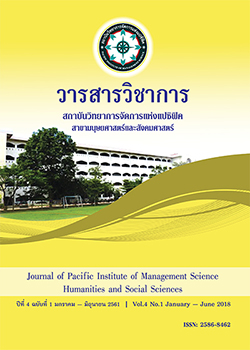Community Waste Management Of Sansuk Municipality, Sriracha District, Chonburi Province
Keywords:
Community Waste Management, Types and Methods of Waste ManagementAbstract
The objective of this study was to investigate the patterns and methods of waste management in Sansuk Municipality, Sriracha, Chonburi. (2) To analyze the strengths and weaknesses of waste management in Sansuk Municipality, Si Racha District. Chonburi in terms of legal policy management. And (3) to provide suggestions for improving the waste management of Sansuk Municipality, Sriracha Municipality, Chonburi and other areas. The similarity.
The study was a qualitative study in In-Depth Interview, with documentary study, observation and waste management study. Of the community
The results showed that solid waste management of Sansuk Municipality, Sriracha District, Chonburi Province. Use Action Plan "Clean Province" (2556 - 2560) under the principle of 3 Rs or 3 shifts is less use, reuse and reuse, and the principle of participation of all sectors. "Prachatai" is a management approach. There are 3 stages of operation: (1) Solid waste management Take a disciplined campaign. Raise awareness for the people. Know the responsibility to help each other in the garbage disposal. (2) Intermediate Solid Waste Management Supervise and control not to cause danger during loading and unloading. Environmental controls prevent spoiled water from flowing down the road. Prevent solid waste from being dumped during transportation. Garbage and solid waste collection services are used for private contractors to collect solid waste. (3) waste management at the destination. Sanitary Landfill (Sanitary Landfill) is used to produce composted gas in the incinerator. And waste disposal system.
Recommendations (1) It should be encouraged and encouraged that local government organizations have the opportunity to select appropriate waste disposal methods for local communities by concession agreements in the form of BOT (Build, Operate, Transfer). The local government is issued. Or waste management measures that are in line with the economic conditions of the community and society. Include the people involved in the monitoring and enforcement of the provisions strictly. Encourage the public sector to invest in the private sector in solid waste management. Hazardous Waste Management should be facilitated by the State, with amendments to laws and regulations. Involve the private sector in the effective implementation of the principles of good governance. It also encourages private investors to invest in large projects. (3) Support or subsidize local budgets with insufficient income for solid waste management. The initial management measures can be implemented as appropriate. And the way of life or the lives of the people. In each locality, the local waste management system (local authority) may be set up in the form of container (bag) at the local authority. And people only need this bag. Otherwise, it will not be stored. (4) The 600 MW / month Moving Grate Incineration project will cost Bt1.2bn, generating 6-7 MW of MWHr. It is a closed system technology. No problem odor. Can burn both wet and dry waste. (5) The state should invest in the establishment of a power plant. The state must encourage private sector to be profitable. There is a payback period, for example, that the private electricity sales to EGAT / PEA / MEA are set at a reasonable price. The Tipping Fee is used to provide income for the private sector to replace landfill waste. At present, waste incineration technology is used to produce electricity. Can bring fresh garbage to burn. Without the cost of producing RDF, the state should support such technology. This cost is paid for the tipping fee to replace the cost of RDF production.
References
กรมควบคุมมลพิษ. (2557). หลักการจัดการคุณภาพน้ำและจัดทำแผนปฏิบัติการในพื้นที่ลุ่มน้ำภาคตะวันออกเฉียงเหนือ. เล่มที่ 3/14. กระทรวงวิทยาศาสตร์ เทคโนโลยี และสิ่งแวดล้อม.
กรมควบคุมมลพิษกระทรวงทรัพยากรและสิ่งแวดล้อม. (2558). มลพิษจากขยะมูลฝอยในชุมชน.กรุงเทพฯ:[ม.ป.พ.].
เกียรติพงษ์ ศรีสว่าง. (2545). การนำกลับมาใช้ใหม่ของขยะมูลฝอย.นครราชสีมา: มหาวิทยาลัยเทคโนโลยีสุรนารี.
ธนกฤต บวกขุนทด. (2553). “รูปแบบการจัดการการจัดเก็บขยะชุมชน”.องค์การบริหารส่วนตำบลโนนเมืองพัฒนาอำเภอด่านขุนทด จังหวัดนครราชสีมา.
สำนักงานสิ่งแวดล้อมกรุงเทพมหานคร. (2010). การจัดการขยะของต่างประเทศ.
สำนักงานคณะกรรมการพัฒนาการเศรษฐกิจและสังคมแห่งชาติ. (2560).
แผนพัฒนาเศรษฐกิจและสังคมแห่งชาติฉบับที่ 8-12. วันที่ค้นข้อมูล 5 ตุลาคม 2560, เข้าถึงได้จากhttp://www.nesdb.go.th/main.php?filename=develop_issue
สุนีย์มัลลิกะมาลย์ และคณะ. (2543). ระเบียบข้อบังคับจัดเก็บค่าธรรมเนียมการคัดแยกประเภทขยะมูลฝอยจากครัวเรือนที่ไม่คัดแยกประเภทขยะมูลฝอยก่อนนำไปทิ้ง เพื่อให้ชุมชนปฏิบัติการคัดแยกประเภทขยะมูลฝอย หากไม่ต้องการจ่ายค่าธรรมเนียม.
อาคม เติมพิทยาไพสิฐ และธานินทร์ ผะเอม. (2552). แผนพัฒนาเศรษฐกิจสังคมแห่งชาติ ฉบับที่ 1-11. การบรรยายหลักสูตรนักบริหารระดับสูงกระทรวงอุตสาหกรรมรุ่นที่ 10.
Waste law. (1975). ออกกฎหมายขยะมูลฝอยเป็นกฎหมายหลักในการจัดการบรรจุภัณฑ์ เกี่ยวกับการกำจัดและการใช้ซ้ำบรรจุภัณฑ์ ในปี ค.ศ. 1992.
Downloads
Published
Issue
Section
License
บทความที่ได้รับการตีพิมพ์เป็นลิขสิทธิ์ของ สถาบันวิทยาการจัดการแห่งแปซิฟิค
ข้อความที่ปรากฏในบทความแต่ละเรื่องในวารสารวิชาการเล่มนี้เป็นความคิดเห็นส่วนตัวของผู้เขียนแต่ละท่านไม่เกี่ยวข้องกับสถาบันวิทยาการจัดการแห่งแปซิฟิค และคณาจารย์ท่านอื่นๆในสถาบันฯ แต่อย่างใด ความรับผิดชอบองค์ประกอบทั้งหมดของบทความแต่ละเรื่องเป็นของผู้เขียนแต่ละท่าน หากมีความผิดพลาดใดๆ ผู้เขียนแต่ละท่านจะรับผิดชอบบทความของตนเองแต่ผู้เดียว







